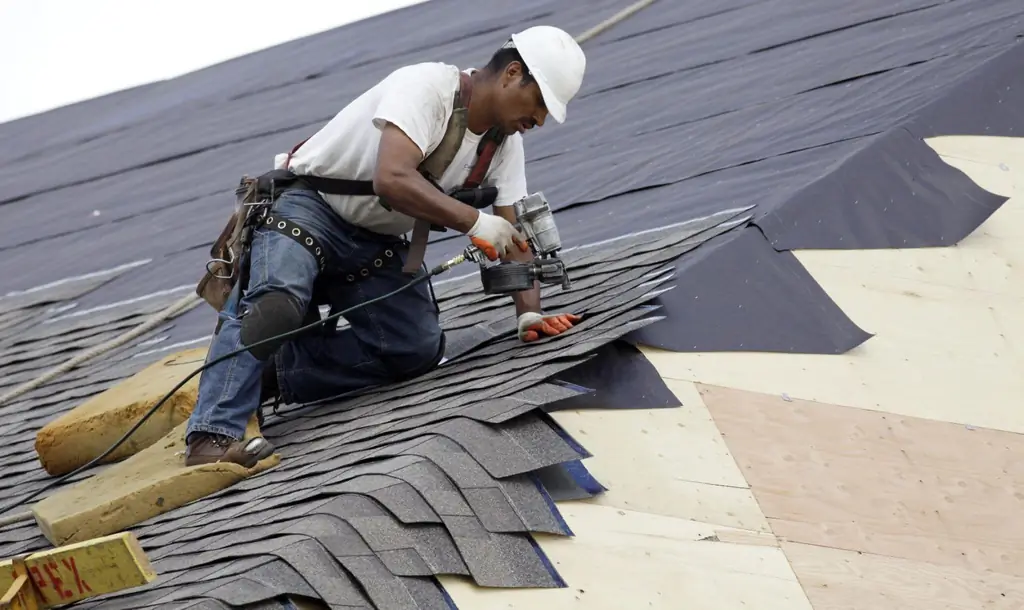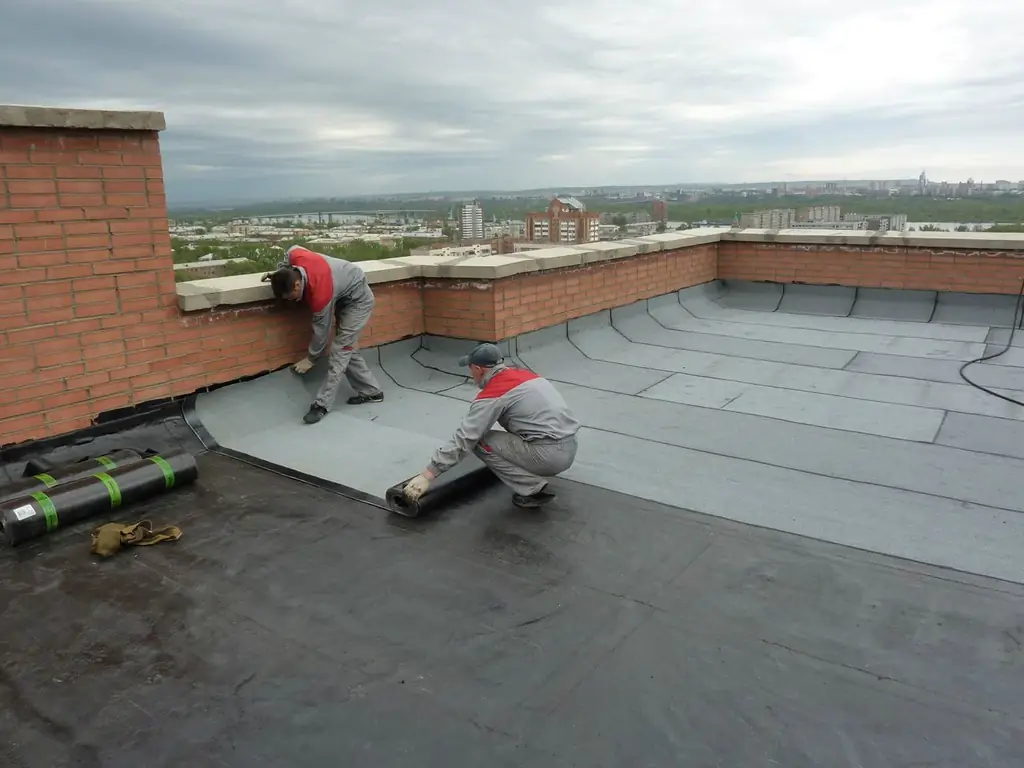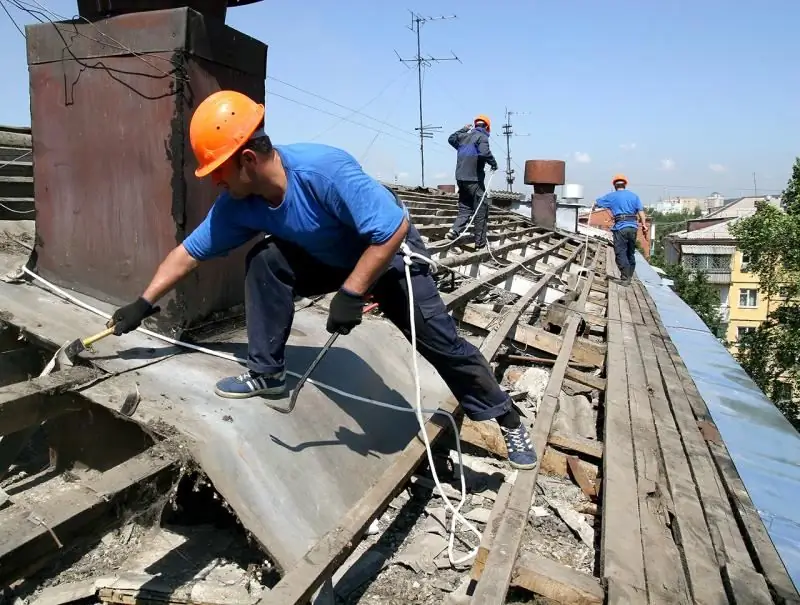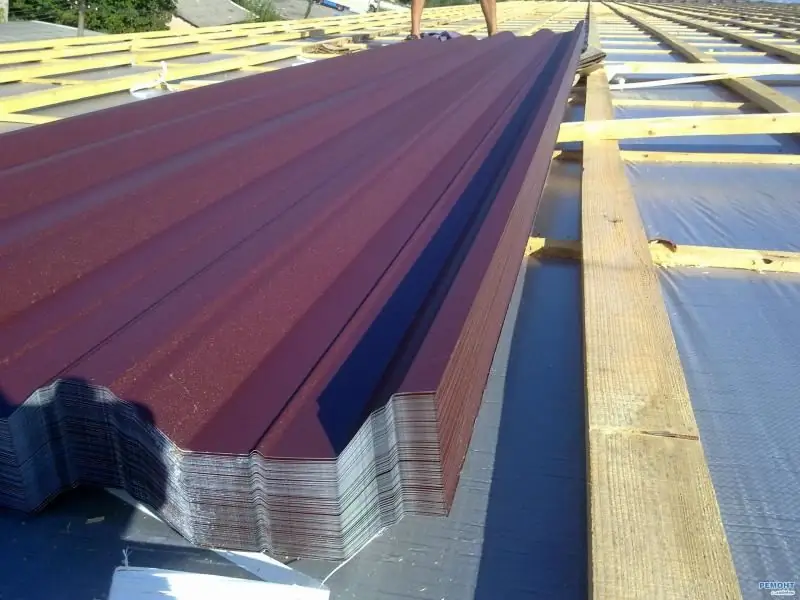
Table of contents:
- Author Bailey Albertson [email protected].
- Public 2023-12-17 12:53.
- Last modified 2025-06-01 07:32.
Dismantling the roof - how to remove the roof covering without losses

Demolition (partial or complete dismantling and demolition of buildings) is increasingly becoming an independent construction industry. As in every type of activity with a narrow focus, there have been developed technologies and rules. Demolition experts with extensive experience and professional equipment surpass newcomers in labor productivity and turnaround time. But when it comes to the private housing sector, property owners prefer to dismantle their homes on their own. It saves money and is somewhat interesting. To help those who find themselves in such a situation, we will outline the practical nuances of dismantling the roof.
Content
- 1 When the roof is dismantled
-
2 Stages of roof dismantling
- 2.1 Dismantling electrical equipment
-
2.2 Dismantling the chimney
2.2.1 Video: how to disassemble a chimney
- 2.3 Removing additional elements
- 2.4 Step-by-step removal of roofing material
- 2.5 Removing the thermal insulation and waterproofing
-
2.6 Dismantling the battens and truss system
2.6.1 Video: dismantling the old crate
-
3 Features of dismantling different types of roofs
-
3.1 Removing the roll roof
3.1.1 Video: roof cutter
-
3.2 Removing the slate roof
3.2.1 Video: slate dismantling
-
3.3 Dismantling the standing seam roof
3.3.1 Video: dismantling the seam roof
- 3.4 Dismantling the roof from the profiled sheet
- 3.5 Dismantling metal roofing
-
When the roof is dismantled
Roof demolition is a complex technological process, accompanied by the disposal of the roof material and requiring considerable financial investments. The decision to dismantle is made on the basis of engineering analysis and is made in the following circumstances.
- During the complete demolition of the building. Due to objective conditions (building density or the impossibility of using blasting operations), a stage-by-stage dismantling of the building is carried out using manual labor and small-scale mechanization.
-
When carrying out a major overhaul of a building in general or a roof in particular. The service life of each material is determined by its technological properties and operating conditions. Over time, destructive processes destroy the integrity of the roof, leaks occur. If there is no alternative solution and ways to restore the coating, it is more expedient to replace the worn-out roof with a new one.

Dismantling a worn-out roof If the materials of the roof frame or elements of the roofing cake are completely worn out, it is better to replace them with new ones.
The difficulty in carrying out dismantling works on the roof is due to a number of factors:
- the roof remnants may fall from a height (chaotic shedding must be avoided);
- dismantling rotten trusses is fraught with collapses, which must be properly controlled;
- partial repairs should not result in the destruction of the remaining roof elements.
The normative document governing the procedure for the dismantling of buildings and structures to be demolished is the Code of Rules SP XXX.1325800.2016, approved by the Ministry of Construction and Housing and Communal Services of the Russian Federation. Clause 6.8 Roof dismantling describes the stages of roof dismantling:
- Dismantling of roofing.
- Dismantling of roof support structures (slabs, rafters or decking).
- Dismantling of adjacent structures - cornices, parapets, pipes, floor slabs, etc.
The size of the strips into which soft, roll and mastic coatings are cut are discussed. It is recommended to keep the size within 1000x500 mm, which is the most convenient for storage and transportation during disassembly.
Roof dismantling stages
Before starting the direct dismantling of the roof, you need to prepare the working site:
- remove all unnecessary items that interfere with dismantling;
- remove billboards and banners, if any;
- prepare communication antennas, electrical cables, ventilation pipes, lightning protection, etc for disassembly;
- inspect and assess the degree of accidents in chimneys;
- install girders and supports in the attic in places where the rafters sink (for pitched roofs);
- in mansard-type roofs, prepare for window removal.
Among other things, it is necessary to think over convenient ways of lifting and lowering workers from the roof to the ground and ways to dispose of construction waste and dismantled roofing
Required tools:
-
long, sturdy ladders reaching roof level;

Roof repair ladders A mobile ladder made of lightweight aluminum with the possibility of attachment to the ridge greatly facilitates the work of installers when dismantling the roof
-
ladders for roofing with a hook at the top;

Roof ladder The hook on the upper end of the ladder is securely fixed in the desired position, therefore, such a ladder will reliably hold the person on it on any roofs
- pry bar, crowbar, hammer, ax with a long handle and wide blade, hand or electric saw;
-
screwdriver or drill with a set of nozzles;

Screwdriver with a set of bits For work on the roof, a battery-powered screwdriver is more suitable
-
safety ropes.

Roof safety ropes All work at height must be carried out only with reliable insurance
If the conditions do not allow the use of special lifting equipment (crane, garbage canal with a tank or container, etc.), a block system is installed to lower the dismantled units. If power is available, use a winch with an electric drive and a rated lifting capacity of at least 0.8 tons. For fastening, strong roof elements are used, the extension of the boom must be at least one meter.

For lifting and lowering construction materials when dismantling the roof, it is convenient to use a stationary winch
Dismantling of electrical equipment
Electrical equipment includes all remote elements of engineering systems located on the roof surface - antennas, air conditioners, lightning protection receivers, lighting devices, etc. Dismantling is carried out only after the equipment and internal communications of the house are completely de-energized. In private houses, the "ground" of the power grid is connected to a common ground loop, to which lightning protection is connected. It is therefore recommended to disconnect the ground terminal from the pantograph bus to avoid injury from stray currents. To ensure safety, a sign "Do not turn on, work in progress" is installed on the switchboard. All preparation should be carried out in dry, calm weather.
Dismantling chimney
The brick pipe is dismantled from top to bottom. The hole is closed with a rag. Breaking off the masonry is carried out using a bricklayer's hammer, crowbar or pry bar. Having brought the disassembly to the plane of the slope, another row is removed, on which the preparation for removing the roof ends. Asbestos and metal pipes are usually attached inside the attic space, so disconnection occurs at the bottom. If the pipe has a large diameter and weight, it can be cut into pieces. Of course, provided that the roof is completely dismantled and the pipe is subsequently replaced with a new one.

Dismantling the chimney is much easier if the chimney is routed from the outside of the building
Video: how to disassemble a chimney
youtube.com/watch?v=iKGegjNim08
Removing additional elements
Additional roof elements include:
-
ridge profile;

Roof ridge Fastening of the ridge to the metal tile is carried out with roofing screws with hats for a hexagonal bit
- cornice and frontal strips;
-
droppers;

Dropper The drip plate is removed after dismantling the vapor barrier film
- decorative spotlights.
Most often, addons are made of sheet metal sheet, coated with a polymer composition. They are fastened with self-tapping screws or roofing nails. Dismantling is carried out using a nail puller or screwdriver. Drippers are disconnected after removing the first row of roofing from the cornice and the gutter. Soffits are dismantled from the stairs. If the extensions are in working order, they can be reused.
Step-by-step removal of roofing material
The algorithm for disassembling various roofing materials is different. The general rule is that dismantling is carried out in the opposite direction to installation. If this is, for example, slate, which is laid from the eaves to the ridge, then the disassembly begins with the ridge and ends with the eaves. However, there are exceptions. Metal seam roofing, if necessary, can be disassembled from anywhere. Having made a transverse cut of the sheet, disassembly is continued in any direction.
In more detail, the types of dismantling of various roofing materials will be discussed in a separate section below.
Dismantling of thermal insulation and waterproofing
After removing the outer layer of the roofing material, the elements of the roofing cake are removed layer by layer. The waterproofing is rolled up and lowered to the ground. Then the insulation mats are removed and, finally, the vapor barrier film is removed. If the materials have not been damaged during operation, they are stored under a canopy so that the precipitation does not wet the mineral wool. Roofing material is rolled into rolls and stored in an upright position without kinks. The vapor barrier membrane is folded like a tablecloth and left in a dry, ventilated place. Sometimes it is more convenient to dismantle the roofing cake from the inside of the pitched roof. In this case, the materials are stored inside the attic.

The roofing cake most often has a standard structure, and its disassembly is carried out in the reverse order.
Dismantling the crate and rafter system
If significant damage is found (including fungus, mold or rot), you have to dismantle the roof truss system. It can be either complete or partial disassembly with the subsequent replacement of trusses. With complete disassembly, dismantling begins with the removal of the crate and the ridge run. Then the crossbars and braces are disconnected. The rafter legs are gently lowered as they are released. If subsequent restoration and reuse is expected, each part is pre-numbered, applying a serial number with paint.

Inside the attic space, special scaffolds are installed so that it is convenient to tear off the sheathing boards along the entire roof height
Work is being carried out from the attic side.
- Disconnect the lateral ties located at an accessible height of 1.5-2 meters from the floor. Punching a through hole in the crate, dismantle the boards located below.
- They arrange a scaffold and with their help bring the dismantling to the very ridge of the roof.
-
The rafters are freed from metal brackets (as well as dowels and brackets) and each rafter leg is lowered separately.

The procedure for disassembling rafters The device of layered rafter systems allows them to be disassembled, alternately disconnecting the elements from each other in a certain order
- When disassembling the hanging rafters, part of the sheathing boards (usually every fourth) is left until the truss is removed. This is necessary so that the rafter structure does not fall.
Video: dismantling the old crate
Features of dismantling different types of roofs
Let's take a closer look at the nuances of disassembling various types of roofing.
Dismantling the roll roof
Dismantling a roof covered with roll materials is a time consuming and, accordingly, expensive process. In the summer, when the temperature in the sun reaches 40 degrees or more, the bituminous layers are sintered into a single monolithic layer. This "carpet" firmly sticks to the base, so removing it can be very problematic. In practice, two methods are used:
-
Disassembly with an ax and a crowbar. The roof ax is an impact chopping tool. The long handle is used to increase the swing and power of the blow. The sharp blade sinks deeply (more than 3 cm) into the hardened roof covering. In this way, pieces of a square or rectangular shape are cut down and then, using a crowbar, they are chipped off from the base of the roof. If the piece is too large, it is broken into pieces using the butt of a roofing ax.

Dismantling the roll roof with an ax From the entire mass of the roll covering, small areas of the covering are carved with an ax, which are then manually removed from the roof
- Dismantling with a mechanical cutter. The device is designed specifically for removing roll roofs on flat roofs and belongs to the category of small mechanization. Moving on wheels along the surface of the roof, the chasing cutter cuts the layers of roofing material to a given depth. Management is carried out by one person. The standard traffic pattern is cutting parallel strips and then dividing them into parts convenient for transportation. There are limitations - the depth of the deposited layer should not exceed 30 mm.
Video: roof cutter
The drive of the rotary mechanism can be electric or autonomous (based on a gasoline engine). The latter usually develops a lot of power.
Dismantling the slate roof
The optimal number of installers for removing slate coverings is a team of three people. You can work together, but the speed will drop dramatically. It is strictly forbidden to dismantle a slate roof alone.
- The skate is disconnected at the intersection of the slopes.
-
Sheets are removed first of the first, and then of the next row located below. At the same time, one of the installers knocks down the nails from below, so that it is convenient to grab them from above with a nailer.

Dismantling slate If the work is carried out by three people, then one of the installers should be in the attic and hammer the nails from below, so that it is more convenient to pull them out
-
Sheets are lowered down stairs or planks.

Descent of a sheet of slate to the ground There must be an assistant at the bottom to receive the drop sheet
- At the bottom, the slate is accepted and stored.
Video: slate dismantling
Dismantling the standing seam roof
The sequence for removing metal strips is as follows:
- Disconnect and remove facing panels located in a vertical plane: on chimneys, ventilation pipes and other superstructures.
- Clears the perimeter around the dormers.
-
Remove ordinary plates in any necessary sequence.

Dismantling the standing seam roof First, all cladding panels at the joints, abutments and around the dormers are removed, and then the metal plates are dismantled in random order
- The gutters are sewn.
- Dismantle overhangs, including eaves and frontal elements.
Usually, disassembly is carried out by progressively moving in a horizontal direction from the left edge of the ramp to the right. Gutters, eaves and soffits are removed from the attic. If the roofing material is supposed to be used in the future, a lapel hammer is used to unclamp the seam joint. If there is no need to preserve the sheets, the recumbent folds are cut off with a roofing chisel.

If the covering sheets need to be saved for later use, a special tool is used to separate them.
Video: dismantling the standing seam roof
Dismantling the roof from the profiled sheet
To dismantle the roof from the corrugated board, a team of at least three assemblers is needed. Detachable sheets are passed “on the baton” from hand to hand until they are on the ground. Dismantling begins with vertically located elements of the lining of pipes, chimneys, and other adjacent structures. Thereafter:
- Wind bars, valleys and ridge are removed.
- The upper roofing sheets are detached and lowered to the ground.
- All other rows of profiled metal sheets are removed.
- Drops, gutters and cornice strips are dismantled.

Well-coordinated work on dismantling the corrugated board can be provided by a team of three people
Dismantling of metal roofing
The metal tile is installed in the same order as the slate - from the bottom up. Therefore, dismantling is done in the opposite direction.
- With the help of a screwdriver, the end wind bars, the places where the coating adjoins to the vertical planes are detached.
- The ridge is removed from the threaded mounts.
- Tile sheets are being dismantled. The order of removal of the coating is dictated by the installation method (with or without offset).
-
A self-adhesive porous seal can be installed on the ventilated ridge, connecting the slopes. It is removed with an ordinary knife.

Dismantling of metal roofing Dismantling of metal tiles begins with disassembling the junction points and removing the ridge element
In conclusion, I would like to once again draw attention to the fact that work at a height, which includes the dismantling of the roof covering, is equated in terms of the level of danger to mining and drilling and blasting. Compliance with safety precautions is the first thing to remember when starting work. Take care of your life and health. Do not neglect safety precautions. Use safety ropes, construction helmets, and other protective equipment.
Recommended:
Repair Of A Soft Roof, Including A Description Of Its Main Stages, As Well As Material And Tools For Work

Diagnostics of the condition of the soft roof. Repair types and their main features. A brief overview of roofing materials and recommendations for their selection
Flat Roof Repair, Including A Description Of Its Main Stages, As Well As Material And Tools For Work

A brief description of the types of flat roof repair. Recommendations for the selection of roofing materials. Technology for eliminating various defects on flat roofs
Roof Repair, Including Its Various Types With A Description Of The Main Stages Of Work

Features of various types of roofing pie repair. Required materials and tools. Step-by-step technology for repairing the main types of roofing
Installation Of Seam Roofing, Including With Your Own Hands, The Main Stages Of Carrying Out, As Well As How To Avoid Major Mistakes

What is a seam roof. What tools and material are needed for installation. Coating laying technology, stages of installation. What mistakes can be made
Installation Of Roofing From Corrugated Board, Including With Your Own Hands, The Main Stages Of Carrying Out, As Well As How To Avoid Major Mistakes

Features of working with profiled sheet when covering the roof. What tools are needed, how to make the crate correctly. Installation errors. How to dismantle and repair
